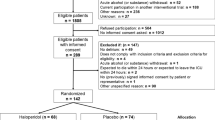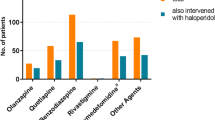Abstract
Background
Practice guidelines recommend the use of low dose haloperidol when medication is needed to treat delirium with acute agitation in hospitalized older people. Despite this, high dose haloperidol may frequently be used and result in higher rates of complications.
Objective
To describe dosages and effects of haloperidol used in the initial treatment of delirium with acute agitation in hospitalized older people, and prescriber use of low and high dose haloperidol.
Methods
Retrospective chart reviews were performed from June 2008 to May 2009 in a community teaching hospital located in Upland, PA, USA. Patients aged 65 years and older with acute agitated delirium were included. Patients admitted to ICU and those with psychiatric conditions were excluded. Data were collected on haloperidol dosing, responses, sedation, length of stay, and concurrent use of lorazepam.
Results
A total of 261 charts of patients who received haloperidol were reviewed and 56 patients met inclusion criteria (14 males, 42 females). The mean age of subjects was 83 years. The recommended starting dose of haloperidol (0.5 mg) was administered to 35.7 % of the patients. An initial dose of more than 1 mg was received by 37.5 % of the patients. The remaining 26.8 % of patients received 1 mg. The relative risk of sedation was significantly greater for subjects receiving more than 1 mg of haloperidol in 24 h. The length of hospitalization was not predicted by haloperidol doses or lorazepam but by the number of days of agitation.
Conclusions
Higher than recommended initial doses of haloperidol were frequently used in the treatment of delirium with acute agitation in hospitalized older people. We found no evidence to suggest that higher dosages were more effective in decreasing the duration of agitation or the length of hospital stay. Low dose haloperidol appears to be as effective as and safer than higher doses in the treatment of acute agitation in this older population.


Similar content being viewed by others
References
Meagher DJ, Leonard M, Donnelly S, Conroy M, Saunders J, Trzepacz PT. A comparison of neuropsychiatric and cognitive profiles in delirium, dementia, comorbid delirium-dementia and cognitively intact controls. J Neurol Neurosurg Psychiatry. 2010;81(8):876–81.
van Munster BC, Yazdanpanah M, Tanck MW, de Rooij SE, van de Giessen E, Sijbrands EJ, et al. Genetic polymorphisms in the DRD2, DRD3, and SLC6A3 gene in elderly patients with delirium. Am J Med Genet B Neuropsychiatr Genet. 2010;153B(1):38–45.
Kudo S, Ishizaki T. Pharmacokinetics of haloperidol: an update. Clin Pharmacokinet. 1999;37(6):435–56.
Geriatric Lexi-Drugs™. Lexi-Comp Online™. Hudson, OH: Lexi-Comp. Assessed 7 Dec 2012. http://www.lexi.com.
American Psychiatric Association. Practice guideline for the treatment of patients with delirium. Am J Psychiatry. 1999;156(5 Suppl):1–20.
Cook IA. Guideline watch: practice guideline for the treatment of patients with delirium. Arlington: American Psychiatric Association; 2004.
NICE. Delirium: diagnosis, prevention and management (clinical guideline 103). National Clinical Guideline Centre. 2010. Accessed 12 Jul 2012. http://www.nice.org.uk/CG103.
Lonergan E, Britton AM, Luxenberg J, Wyller T. Antipsychotics for delirium. Cochrane Database Syst Rev. 2007(2):CD005594.
Flaherty JH, Gonzales JP, Dong B. Antipsychotics in the treatment of delirium in older hospitalized adults: a systematic review. J Am Geriatr Soc. 2011;59(Suppl 2):S269–76.
Inouye SK, Leo-Summers L, Zhang Y, Bogardus ST Jr, Leslie DL, Agostini JV. A chart-based method for identification of delirium: validation compared with interviewer ratings using the confusion assessment method. J Am Geriatr Soc. 2005;53(2):312–8.
Inouye SK, van Dyck CH, Alessi CA, Balkin S, Siegal AP, Horwitz RI. Clarifying confusion: the confusion assessment method. A new method for detection of delirium [see comment]. Ann Intern Med. 1990;113(12):941–8.
SAS 9.1. Cary, NC, USA: SAS Institute Inc.; 2002–2003.
Carnes M, Howell T, Rosenberg M, Francis J, Hildebrand C, Knuppel J. Physicians vary in approaches to the clinical management of delirium. J Am Geriatr Soc. 2003;51(2):234–9.
Kapur S, Remington G, Jones C, Wilson A, DaSilva J, Houle S, et al. High levels of dopamine D2 receptor occupancy with low-dose haloperidol treatment: a PET study. Am J Psychiatry. 1996;153(7):948–50.
Tauscher J, Kapur S. Choosing the right dose of antipsychotics in schizophrenia: lessons from neuroimaging studies. CNS Drugs. 2001;15(9):671–8.
Neborsky R, Janowsky D, Munson E, Depry D. Rapid treatment of acute psychotic symptoms with high- and low-dose haloperidol. Behavioral considerations. Arch Gen Psychiatry. 1981;38(2):195–9.
Young J, Inouye SK. Delirium in older people. BMJ. 2007;334(7598):842–6.
Young J, Murthy L, Westby M, Akunne A, O’Mahony R, Guideline Development Group. Diagnosis, prevention, and management of delirium: summary of NICE guidance. BMJ. 2010;341:c3704.
Inouye SK, Bogardus ST Jr, Baker DI, Leo-Summers L, Cooney LM Jr. The Hospital Elder Life Program: a model of care to prevent cognitive and functional decline in older hospitalized patients. Hospital Elder Life Program. J Am Geriatr Soc. 2000;48(12):1697–706.
Kyle R, Allen SMF, Rex Wilford et al. Implementation of delirium prevention and treatment protocols can decrease the incidence and negative consequences of delirium in the acute care hospital. These protocols are easily incorporated into daily work processes. J Clin Outcomes Manage. 2011;18(6):253–8.
Flacker JM, Marcantonio ER. Delirium in the elderly. Optimal management. Drugs Aging. 1998;13(2):119–30.
Acknowledgments
Dr. Zirker contributed to the study concept and design. Drs. Dorokhine, Patel, and Musuku contributed to data acquisition. Dr. Knapp contributed to data analysis. All authors contributed to analysis and interpretation of data, writing, editing, and revising the paper critically for important intellectual content, and final approval of the manuscript.
There was no source of funding for this study. There were no study sponsors. Drs. Zirker, Dorokhine, Knapp, Patel, and Musuku have no conflicts of interest to report.
We would like to thank Michael Srulevich, MD for his support and helpful suggestions, and Donna Peterson, PharmD for helpful suggestions and help with data collection from the pharmacy database.
Author information
Authors and Affiliations
Corresponding author
Rights and permissions
About this article
Cite this article
Zirker, W., Dorokhine, I., Knapp, C.M. et al. Haloperidol Overdosing in the Treatment of Agitated Hospitalized Older People with Delirium: A Retrospective Chart Review from a Community Teaching Hospital. Drugs Aging 30, 639–644 (2013). https://doi.org/10.1007/s40266-013-0087-7
Published:
Issue Date:
DOI: https://doi.org/10.1007/s40266-013-0087-7




